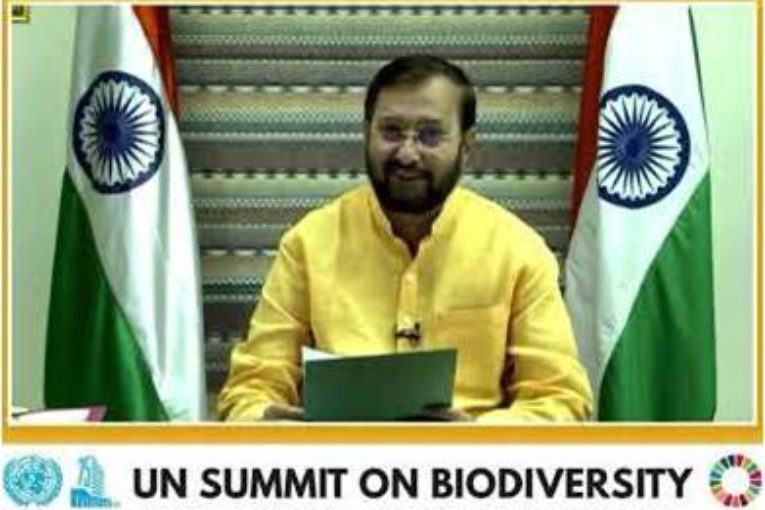
FGR Bureau
Biodiversity and ecosystem services underpin the epitome of sustainable development with twin goals of natural resource management and livelihoods simultaneously integrated in every biodiversity action plan. Since ecosystem restoration and realization of cross-goals SDGs 2030 has heightened our commitments to achieve biodiversity related targets, it has become imperative that actors across sectors systematically integrate biodiversity management through multi-stakeholder partnership.
The First ever Summit on Biodiversity was convened under the theme “Urgent Action on Biodiversity for Sustainable Development” on September 30 by the Secretariat of the Convention on Biological Diversity and the United Nations Environment Programme. Representing India at the Summit on the occasion of 75th anniversary of the UN General Assembly, Union Minister for Environment, Forest and Climate Change, Shri Prakash Javadekar, highlighted that ‘As we are approaching the end of the UN Decade on Biodiversity 2011-2020, there is an urgent need to accelerate actions to conserve biodiversity.’ As enshrined in our Vedic scripts “Prakriti Rakshati Rakshita” stating that if you protect nature, nature will protect you. He rightly remarked that it is due to these beliefs and ethos that India, with only 2.4% of the earth’s land area hosts around 8% of the world’s recorded species. We are in affirmative alignment to such enriching views and India has always represented distinctness and unique culture to portray nature based measures towards the cause of climate change, environmental degradation.
Major Takeaways
The fifth edition of the Global Biodiversity Outlook (GBO-5) was launched suggesting pursuing a “portfolio of actions” towards enhancing conservation and restoration of ecosystems; mitigating climate change; take action on pollution, invasive alien species, and overexploitation; moving towards more sustainable production of goods and services; and reducing consumption and waste.
India has already taken stewardship role in order to conserve biodiversity by organizing two Conference of Parties (CoPs) i.e. CoP-14 of United Nations Convention to Combat Desertification (UNCCD) and CoP-13 of Convention on Migratory Species (CMS) and set aside extensive area for meeting the conservation objectives, contributing to Aichi Biodiversity Target-11 and the SDG -15. Nexus approach should become an integral part of biodiversity policies as a sine qua non for attaining sustainable development.
UNGA President Volkan Bozkir called on Member States to use the Summit to build political momentum towards a post‑2020 global biodiversity framework to be adopted at the 15th meeting of the Conference of the Parties (COP 15) to the CBD to be held in Kunming, China in 2021. “Kunming must do for biodiversity what Paris did for climate change,” said Bozkir, by placing the biodiversity discourse firmly on the political agenda. The Leaders’ Pledge for Nature, launched in support of the first UN Summit on Biodiversity, was developed by the Alliance of Small Island States, Belize, Bhutan, Colombia, Costa Rica, the EU, Finland, Kenya, Seychelles, and UK, with intergovernmental and non-governmental partner organizations.
Improving Biodiversity Landscape
With the trinity of ‘Super Year for Nature and Biodiversity, UN Decade on Ecosystem Restoration and realization of SDGs 2030’, deploying biodiversity-related solutions are urgently the need of the hour. Strategic perspective actions in corresponding biodiversity plans shall highlight the broad contours of sectors such as Water Resources, Agriculture, Forestry, Energy along with Climate Change Adaptation, Knowledge Management and capacity building through whole-of-society perspective. Transversal priorities to build water, agriculture, forestry and soil shall appropriately integrate sustainable use, conservation and restoration of biodiversity, strengthen energy efficiency, mainstream climate resilience in food systems, improve regional knowledge sharing and capacity building and adopt green practices that will help build climate resilience and support transition to sustainability by reducing trade-offs and generating additional benefits.
The post-2020 global biodiversity framework that will be adopted at the 15th Conference of Parties to the CBD in 2021 provides a good opportunity to enhance efforts to conserve and protect nature and an opportunity to restore 26 million hectares of degraded and deforested land, and achieve land-degradation neutrality by 2030. It is time we champion the cause of “biodiversity action” through conservation and green development endeavors. But, at the outset, let’s position biodiversity at the heart of sustainable development to build back better for a sustainable forward.



